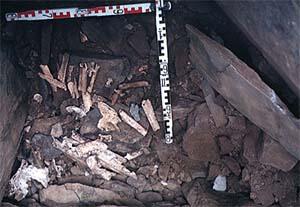- Home
- Discover the megaliths of Morbihan
- Monumentalism
- Did you know ?
- The disposition of corpses
Men have always used two techniques to overcome the problem of how to dispose of corpses: burial or incineration. These techniques led to the emergence of many forms of inhumation and cremation rituals. However, neither one ever totally replaced the other.
The bodies are placed in graves which are either isolated or grouped together in necropoles.
Bodies may have been buried in collective graves, one by one as people died, or all together (after a slaughter or an epidemic, for example).
Bodies would be either kept in the "open" (directly exposed to the air), "confined" (wrapped in a shroud) or "sealed off" (buried in the earth, with or without some form of protection). Bone disarticulation would take place differently according to the burial technique.
The body may be buried in a natural position, either lying down (dorsal or lateral decubitus) or bent, or may be in a forced position (bonds being used to force the limbs into an unnatural position).
Tomb in the trunk of Locquirec (Finistère). Some Bronze Age tombs were so well adjusted that they were able to preserve their contents from infiltration.
Chamber of the Dolmen of Saint-Thois (Finistère). The collapse of the vault formed a tangle of slabs allowing the partial conservation of the bones.
Single-use individual or collective graves were usually closed permanently by tumulation. Multiple-use collective graves, on the other hand, had to be opened again in order to inter new bodies. Such graves were therefore equipped with an entrance.
Graves in which bodies were placed directly are called primary graves. Graves where bodies were already processed, in whatever way (natural decomposition, cremation or mummification, etc.), are called secondary graves.
A mausoleum is a monument build on top of a grave in order to remember the dead and to create a funeral cult.
A cenotaph is also a monument aimed at developing a funeral cult, but does not mark a grave (a memorial, for example).
The status of a grave could change with time: a collective grave could eventually be sealed, while on the contrary, an individual grave might be re-opened and re-used. Similarly, the ritual could change: cremated bodies or secondary burials could be placed in primary graves (and vice versa).
Exploded view of Gavrinis. In the heart of a quadrangular cairn, the room is served by its access corridor.



